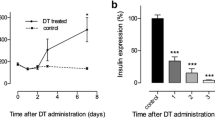Summary
Whole-body autoradiographic and densitometric distribution studies were performed on rats to investigate the accumulation of[14C]dimethadione (DMO) in the pancreas. [14C]DMO was intravenously administered at a dose of 167 μCi/0.5mg/kg. Animals were sacrificed 1,15, 30, 60 and 180 min after administration of the radioactive compound. The compound was found to rapidly distribute in all body tissues. The distribution pattern of the compound in the pancreas was spotty or linear due to the presence of the radioactive compound in blood of intrapancreatic vessels and in pancreatic ducts at higher levels than parenchyma. The radioactivity of pancreatic ducts became more evident with time, indicating the gradual accumulation of the compound in the ducts. These findings provide morphological evidence that DMO is accumulated in the pancreas and possibly eliminated from pancreatic juice. Densitometry revealed that the levels of radioactive compound in the pancreas were virtually as high as those in the liver and kidney.
Similar content being viewed by others
References
Butler TC: Quantitative studies of the demethylation of trimethadione (Tridione). J Pharmacol Exp Ther 1953;108:11–17
Waddell WJ, Butler TC: Calculation of intracellular pH from the distribution of 5, 5-dimethyl-2, 4-oxazolidinedione (DMO): Application to skeletal muscle of the dog. J Clin Invest 1959; 38: 720–729
Noda A, Toda Y, Hayakawa T, et al: The excretion of 5, 5-dimethyl-2, 4-oxazolidinedione from the canine pancreas and liver. Am J Dig Dis 1973; 18: 498–505
Noda A, Hayakawa T, Nakajima S, et al: Pancreatic excretion of 5, 5-dimethyl-2, 4-oxazolidinedione in normal subjects. Am J Dig Dis 1975; 20: 1011–1018
Kamiya N: Study on the excretory mechanism of 5, 5-dimethyl-2, 4-oxazolidinedione in the canine pancreas. Jpn J Gastroenterol 1978; 75: 216–223 (in Jpn)
Noda A, Hayakawa T, Aoki I, et al: Pancreatic excretion of 5, 5-dimethyl-2, 4-oxazolidinedione in patients with chronic pancreatitis. Am J Dig Dis 1975; 20: 1019–1026
Noda A, Kamiya N, Hayakawa T, et al: Pancreatolithiasis and pancreatic carcinoma; Evaluation of pancreatic excretion test with 5, 5-dimethyl-2, 4-oxazolidinedione. Arch Intern Med 1977; 137: 754–760
Noda A, Hayakawa T, Kondo T, et al: Clinical evaluation of pancreatic excretion test with dimethadione and oral BT-PABA test in chronic pancreatitis. Dig Dis Sci 1983; 28: 230–235
Noda A, Shibata T, Hayakawa T, et al: Pancreatic stones dissolution with dimethadione (DMO) II: Roentgenological follow-up study in canine experimental pancreatic stones. Jpn J Gastroenterol 1984; 81: 254–262 (in Jpn)
Noda A, Shibata T, Haniano H, et al: Trimethadione (troxidone) dissolves pancreatic stones. Lancet 1984; ii: 351–353
Noda A, Shibata T, Ogawa Y, et al: Dissolution of pancreatic stones by oral trimethadione in a dog experimental model. Gastroenterology 1987; 93: 1002–1008
Ullberg S: Studies on the distribution and fate of S35-benzyl-penicillin in the body. Acta Radiol Suppl 1954;118: 1–110
Matsuoka O, Kashima M: Techniques and applications of macroautoradiography. Radioisotopes 1966; 15:195–207
Noda A, Hayakawa T, Mizuno R, et al: The excretion of dimethadione in pure pancreatic juice and bile in postoperative patients. Gastroenterol Jpn 1984; 19:121–126
Waddell WJ, Butler TC: Renal excretion of 5, 5-dimethyl-2, 4-oxazolidinedione (product of demethylation of trime-thadione). Proc Soc Exp Biol Med 1957; 96: 563–565
Jensen BN: Trimethadione in serum of patients with petit mal epilepsy. Dan Med Bull 1962; 9: 174–79
Author information
Authors and Affiliations
Rights and permissions
About this article
Cite this article
Noda, A., Kameya, S., Isobe, E. et al. Macroautoradiographic and densitometric studies of [14C]dimethadione in rats: Accumulation of the compound in the pancreas. Gastroenterol Jpn 23, 56–60 (1988). https://doi.org/10.1007/BF02918857
Received:
Accepted:
Issue Date:
DOI: https://doi.org/10.1007/BF02918857




